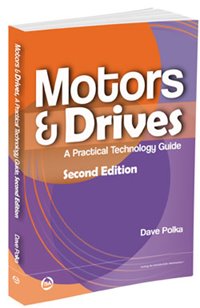
ISA recently published the second edition of Motors & Drives: A Practical Technology Guide by Dave Polka, a widely recognized expert in developing training and technical support materials for major drive manufacturers. In this Q&A feature, Polka highlights the focus, importance, and differentiating qualities of this new edition.
Note: David Polka's biography is included at the bottom of this page.
Q. How would you describe the second edition of your book?
A. The second edition of my book continues to serve as a practical, straight-forward reference guide to the engineering concepts of motors and drives. However, this book goes beyond the “unchanging basics” to the technological advancements that make today’s equipment more feature rich—at a very competitive price. It explains how today’s drives are keeping pace with market demands and the need for easier-to-implement products. At the same time, it attempts to demystify the more difficult-to-understand concepts found in the rotating machinery and controls industry. As a result, I’ve added a significant amount of new and enhanced content.
Q. Could you highlight some of the most significant areas of new and enhanced content?
A. Since the first printing of the book, many changes in the motor speed control industry have occurred. This second edition takes a fresh look at the state of the industry and where the motor control industry is headed. To reflect this, the book includes quite a bit of new and enhanced content, with extensive explanations of them both.
The second edition incorporates a significant amount of new material, including:
- An overview of advances in AC motor types (such as Permanent Magnet and Synchronous Reluctance)
- A new section on "soft-starters" (which provide smooth motor acceleration to a constant speed.)
- A new section on AC drives and machine safety (a critical exploration of machinery directives, and how those standards relate to requirements such as: Safety Integrity Level ratings, Safe Torque Off, Safety categories, Functional Safety, and PL categories)
- A new section on fieldbus communications, Programmable Logic Controller (PLC)-drive interface, touch screen panels with Human Machine Interfaces, Ethernet, fiber-optic and copper-wired communications, Master (Leader)-Follower communications and the improved "easy-to-use technology"
- New applications examples using these improved communications and PLC technologies
The second edition provides enhanced content on essential topics, particularly those relating to:
- Energy efficiency with variable frequency drives (VFDs )-how much energy savings can be realized, and the methods of achieving the savings
- AC induction motors (with references to "Inverter Duty Ratings")
- DC drives (Some manufacturers are moving away from DC in favor of AC products. Several DC drive manufacturers are still focusing on improved DC technology that address current and future market needs.)
- Harmonics and how ultra-Low harmonic and multi-pulse drive solutions meet the ever-growing demand for power quality improvements
- Electromagnetic interference and radio frequency interference and how drive technology has minimized these effects
- Innovations in AC drives (including enhanced programmability, Bluetooth keypad interface, programming templates, wizards, adaptive and function-block and sequential programming, IEC-61131-3 programming capability, the development of industry-related drive products for food and beverage, HVAC, water-wastewater and chemical, and oil and gas industries)
- Drive troubleshooting (including improved diagnostics, laptop tools, and remote monitoring)
- Theory and control concepts (enabling a deeper understanding of difficult concepts)
- The Final Review (includes test questions and answers to assist the reader in mastering key points)
- The "Terms and Definitions" section, which provides up-to-date descriptions of commonly used terms and concepts found in this industry
Q. What are some of the other ways your book differs from others written on the subject?
A. Drives in general have improved dramatically over the last decade. They are smarter, easier to program and implement, and provide superior diagnostic capabilities for on-site or remote monitoring. The emphasis on machine safety and operator safety in general has caused the drives industry to respond with technology that integrates seamlessly with external equipment. It is common-place to see VFDs (variable frequency drives) connecting with a host of higher-level controllers. VFDs play a key role in the pursuit of energy saving devices that improve productivity and reduce operating costs.
Q. Why does the cover of your book depict springs and gears? How are they related to the content of the book?
A. There are several books written on the subject of drives—with many touting theory, formulas, engineering-speak approach to motor control theory. There are a few that are so basic that little information is gained, other than a short overview. My book examines motor control from the perspective of normal, everyday technicians and electricians who are trying to get a job done, and want to cut through theory, and get to the practical.
The book also covers current and new machinery safety standards as well as the interface with automation controls (Other books focus mostly on theory and troubleshooting). My book also digs into the newer motor technology, such as synchronous reluctance and permanent magnet designs, and diagnostics.
